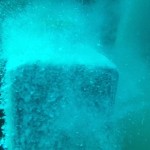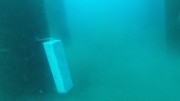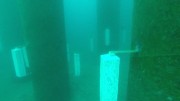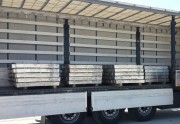+90 324 326 05 95
Aluminyum İndiyum Anot
Anasayfa / Aluminyum İndiyum Anot
Alüminyum Anotlar
Alüminyumun standart elektromotor kuvveti serisindeki yerine göre çinkodan daha aktif bir metaldir. Buna rağmen saf alüminyum deniz suyu içinde doygun bakır / bakır sülfat referans elektroduna karşı -900 mV civarında bir potansiyel gösterir.
Saf alüminyumun galvanik anot olarak kullanılmasına engel oluşturan bu durum, alüminyum yüzeylerinin ince bir oksit filmi ile kaplanarak pasifleşmesinden ileri gelir. Bu pasifleşme özelliği nedeni ile alüminyum 1950 yıllarına kadar galvanik anot olarak kullanılamamıştır. Başlangıçta alüminyum içine % 3 oranında çinko ve % 0,5 oranında kalay katılarak deniz suyu içindeki akım verimi %50 ye ve potansiyeli de - 1,3 Volt’a kadar çıkarılabilmiştir.
1960 lı yıllardan sonra yapılan araştırmalarda alüminyum anot olarak bazı üçlü alaşımlar da denenmiş ve (Al +Zn + Hg) , (Al + Zn + Sn ) , (Al + Zn + In) gibi alaşımların galvanik anot olarak yüksek performans göstermiş oldukları belirlenmiştir. Bu alaşımların elektrot potansiyelleri - 1,05 V ‘ dan daha negatif ve akım verimleri de % 90 civarındadır.
Alüminyum anot bileşiminde bulunan yabancı metaller anot performansını değişik şekillerde etkilemektedir. Bakır ve nikel, alüminyumun potansiyelinin pozitif yöne doğru kaymasına neden olmaktadır. Çinko, mağnezyum ve kadmiyum ise, pasifleşmeyi azaltıcı yönde etki yapmaktadır. Civa, kalay ve indium metalleri alüminyumun sürekli aktif halde kalmasını sağlamaktadır.
Anot bileşiminde % 0,03 ile % 0.05 oranında civa bulunması halinde alüminyum anotlar sürekli aktif halde kalmaktadır. Civa katkılı alüminyum anotlar özellikle deniz suyu içinde çok iyi bir performans göstermesine rağmen çevre kirlenmesi açısından zararlı bulunmuştur. Bu nedenle aktivite bakımından ayni etkiyi gösteren indium alaşımlı alüminyum anotlar tercih edilmektedir. Deniz suyu içinde kullanılan indium alaşımlı alüminyum anotların kimyasal bileşimleri aşağıdaki gibidir.
Deniz suyu içinde kullanılan alüminyum anotların % bileşimleri



AlZnIn GACP anodes are in accordance with ISO 15589-2, supported and refined by DNVGL-RP-B401 and NACE SP0169. AlZnIn GACP bracelet anodes are in accordance with ISO 15589-2, supported and refined by DNVGL-RP-F103 and NACE SP0169.
Anode materials shall fulfil the requirements of ISO 15589-2 and DNVGL-RP-B401. Anode materials for all type anodes are fulfil the requirements of ISO 15589-2, DNVGL-RP-F103, and BS EN ISO 12496.
Customization
Anodes can be customized to fit almost any requirement.
Type approval
The aluminum alloyed anodes comply with the DNVGL DNVGL-CP-0107 – sacrificial anode materials, Det Norske Veritas’ Recommended Practices, DNVGL-RP-B401. The anodes can be provided in accordance with the NORSOK M-503 and/or DNVGL-RP-B401. Other standards can be met upon request.
The EDOPEC range of aluminum anodes is designed for use in a wide range of applications. Typical applications are pipelines, storage tank internals, offshore platforms, ships tanks, etc. The range is wide and we give below typical dimensions.Alternative dimensions and weights are available to suit your specific requirements. Attachment may be by direct welding or by purpose made clamps designed to suit the particular application. The following alloy specifications are widely used.
|
Alloy Composition |
Alloy A |
Alloy B |
Alloy C |
|
Zinc |
3.5-5.0 |
0.5-6.0 |
0.3-0.8 |
|
Aluminium |
Balance |
Balance |
Balance |
|
Magnesium |
- |
0.02 max |
- |
|
Copper |
0.01 max |
0.005 max |
0.005 max |
|
Silicon |
0.05-0.2 |
0.1 max |
0.2 max |
|
Iron |
0.15 max |
0.13 max |
0.12 max |
|
Titanium |
0.01-0.05 |
0.02 max |
0.05 max |
|
Mercury |
- |
- |
0.03-0.06 |
|
Bismuth |
0.05-0.15 |
- |
- |
|
Indium |
0.02-0.05 |
0.01-0.05 |
- |
|
Nominal Capacity AH/kg |
2700 |
2550 |
2830 |
|
Solution Potential (mV) |
-1100 |
-1080 |
-1050 |
|
Density (kg/m3) |
2710 |
2700 |
2660 |
|
Closed Circuit Potential |
Seawater: min. -1.050V wrt Ag/AgCl/seawater reference electrode Sediments: min. -1.000V wrt Ag/AgCl/seawater reference electrode |
|
Minimum Capacity |
Seawater: 2500 Amp.hours per kg at 30oC (Test data only) Seawater: 2000 Amp.hours per kg at 30oC (Practical) Sediments: 2000 Amp.hours per kg at 30oC (Test data only) Sediments: 1500 Amp.hours per kg at 30oC (Practical) |
Alloy A Alloy A is suitable for use on buried pipelines, coated sub-sea structures, offshore jackets and general piled structures. It can be used at low current densities and elevated temperatures.
Alloy B Alloy B is a general purpose anode alloy based on Aluminum and Zinc and is used for general sea water applications at normal temperature.
Alloy C Alloy C is also a general purpose alloy using mercury to give an improved efficiency at a lower solution potential. It is not suitable for high temperature applications. This alloy is now not used often because of the mercury content and the effect on the environment.

Please see the more detail from(EDO-DRG-COE-COR-INT-XXX-020-881-1724-Rev-A-AL-IN-ZN ANODE DETAIL EDO-AL-IN-ZN-RND15100-BOLTED ANODES) Here is this link. and file Datahseets
Please see more detail the following links
EDO-DRG-COE-COR-INT-XXX-020-877-1720-Rev-A-HUGE STRUCTURAL AL-IN-ZN ANODE DETAIL EDO-AL-IN-ZN-XXX.pdf
EDO-DRG-COE-COR-INT-XXX-020-878-1721-Rev-A-SEA SHIP TYPE AL-IN-ZN ANODE DETAIL EDO-AL-IN-ZN-XXX.pdf
EDO-DRG-COE-COR-INT-XXX-020-879-1722-Rev-A-HEATER TYPE AL-IN-ZN ANODE DETAIL EDO-AL-IN-ZN-XXX.pdf
EDO-DRG-COE-COR-INT-XXX-020-880-1723-Rev-A-OFFSHORE PILES AL-IN-ZN ANODE DETAIL EDO-AL-IN-ZN-XXX.pdf
